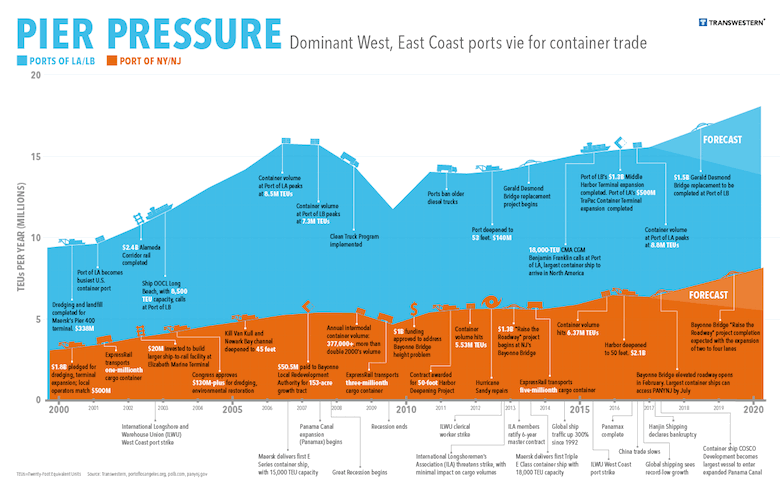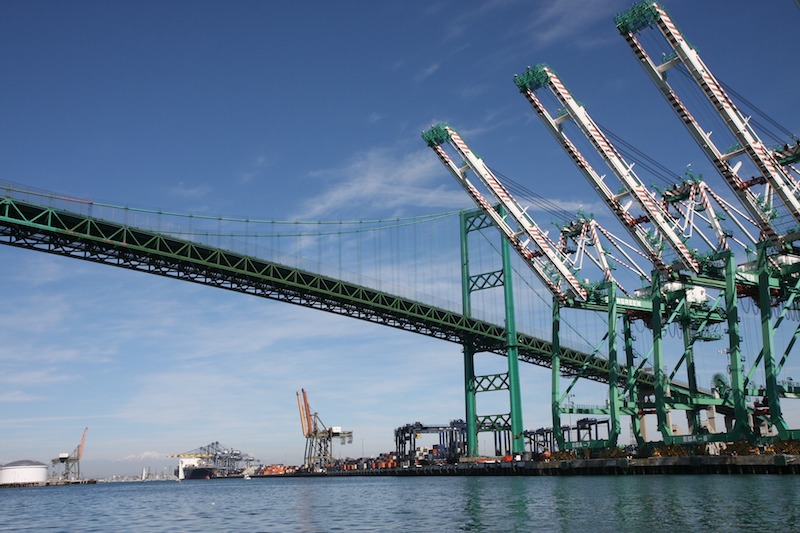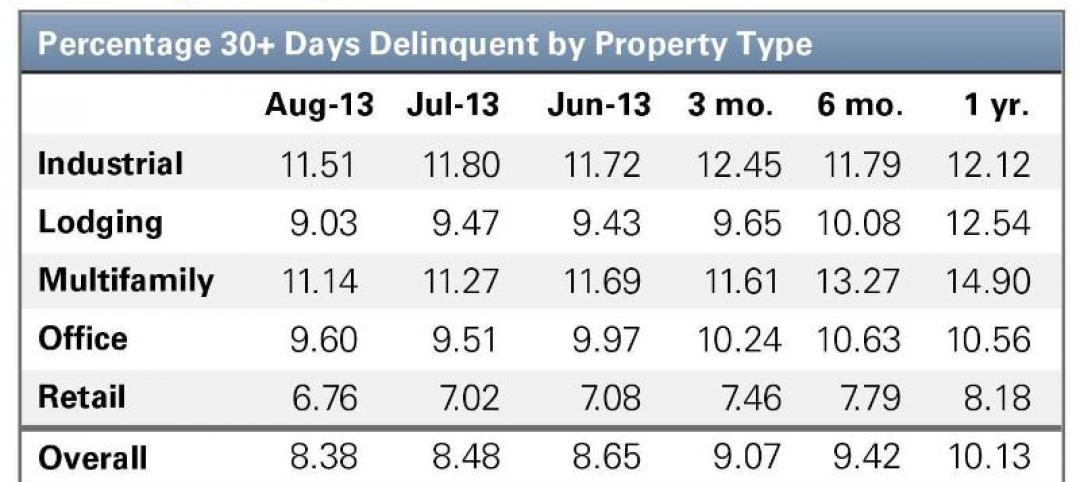The $5 billion Panama Canal expansion (Panamax) opened in late June 2016, making direct access of larger ships from China and elsewhere to America’s East Coast ports more expedient.
But well before that opening, three dominant U.S. ports were engaged in large-scale growth efforts to hold onto and increase their share of that anticipated container trade.
Ports of Los Angeles and Long Beach, Calif., and the Port of New York and New Jersey have spent the past two decades deepening channels, raising bridges, and investing in terminal automation and dockside infrastructure (see chart).
Since Panamax opened, the Port of Long Beach has completed a $1.3 billion Middle Harbor Terminal expansion; and the Port of Los Angeles—whose container volume peaked this year at 8.8 million Twenty-Foot Equivalent Units (TEUs)—completed a $500 million TraPac Container Terminal Expansion.
The Port of New York/New Jersey spent $2.1 billion to deepen its harbor to 50 feet. And by opening an elevated Bayonne Bridge, the largest container ships now have access to the Port of NY/NJ.
CLICK IMAGE TO ENLARGE
 This chart shows the relationship between the development and construction actvities at America's three largest ports— Los Angeles, Long Beach and New York/New Jersey—and their increases in container volumes. Image: Transwestern.
This chart shows the relationship between the development and construction actvities at America's three largest ports— Los Angeles, Long Beach and New York/New Jersey—and their increases in container volumes. Image: Transwestern.
Despite predictions that the Panama Canal widening would disseminate some shipping away from major ports to an array of smaller markets on the Gulf and East Coasts, the ports of Los Angeles and Long Beach and Port of NY/NJ “have retained their stature as the dominant entry points for containerized merchandise and manufacturing components to be assembled domestically,” observe two executives from Transwestern, the national real estate firm.
In its recent edition of “Ask the Expert,” Transwestern’s Director of Research for New Jersey Matthew Dolly and Research Manager for Southern California Michael Soto point out that, as activity at these ports increases, rent rates have been rising, but still take a back seat to transportation costs and access to labor as factors determining where businesses select space.
Panamax has caused some shifts in where ships from Asia and elsewhere unload in the U.S. The Ports of Long Beach and Los Angeles, America’s two largest ports, once received half of all containerized goods entering the U.S. Last year they handled a combined 15.6 million TEUs, or just under one-third of national volume. The authors state that these ports’ combined volume is projected to increase by 3.9% annually through 2040.
The Port of NY/NJ recognized opportunities from increasing shipping travel through the Suez and Panama Canals. Last year, its annual volume peaked to 6.25 million TEUs, or 13% of U.S. volume, and became America’s third-largest port. The authors say that this port has been “catching up” to its West Coast competitors.
In general, busy ports are catalysts for industrial and commercial development around them. This is even truer now that several ports have positioned themselves to receive higher container volumes from giant ships.
About one-third of containerized cargo entering the L.A and Long Beach ports stays in the region to serve 20 million local consumers. And given New York and New Jersey’s population density, they are lucrative destinations for imported goods, many of which travel through the Suez Canal.
“As the world’s concentration of low-cost labor shifts from China to India and other markets bordering the Indian Ocean, the volume of goods passing through the Suez Canal to enter the U.S. via East Coast ports will likely increase,” the Transwestern authors write.
Warehouse and distribution spaces on both coasts are at a premium. And, say the authors, it appears that retailers and manufacturers seem willing to accept higher rents to be closer to those distribution points nearer the ports. “Developers must decide how far away from the region’s population center they can build before the distance makes a location impractical for distribution centers,” the authors write.
The ports in southern California and the New York metro region have committed to maintaining and improving their surrounding infrastructures to be able to handle the transportation of high cargo volumes. Last year, for example, New Jersey’s Transportation Trust Fund earmarked $400 million in annual funding for road, bridge and transit improvements.
In Southern California, major infrastructure improvements include the $1.5 billion replacement of the Gerald Desmond Bridge in Long Beach, to allow access to the port for the tallest container shops. The new bridge will have six lanes (two more than the existing span), as well as a bike lane and observation deck. It’s scheduled for completion next year, at which point it will span 8,800 feet.
Related Stories
| Sep 19, 2013
6 emerging energy-management glazing technologies
Phase-change materials, electrochromic glass, and building-integrated PVs are among the breakthrough glazing technologies that are taking energy performance to a new level.
| Sep 19, 2013
Roof renovation tips: Making the choice between overlayment and tear-off
When embarking upon a roofing renovation project, one of the first decisions for the Building Team is whether to tear off and replace the existing roof or to overlay the new roof right on top of the old one. Roofing experts offer guidance on making this assessment.
Smart Buildings | Sep 13, 2013
Chicago latest U.S. city to mandate building energy benchmarking
The Windy City is the latest U.S. city to enact legislation that mandates building energy benchmarking and disclosure for owners of large commercial and residential buildings.
| Sep 13, 2013
Chicago latest U.S. city to mandate building energy benchmarking
The Windy City is the latest U.S. city to enact legislation that mandates building energy benchmarking and disclosure for owners of large commercial and residential buildings.
| Sep 11, 2013
BUILDINGChicago eShow Daily – Day 3 coverage
Day 3 coverage of the BUILDINGChicago/Greening the Heartland conference and expo, taking place this week at the Holiday Inn Chicago Mart Plaza.
| Sep 10, 2013
BUILDINGChicago eShow Daily – Day 2 coverage
The BD+C editorial team brings you this real-time coverage of day 2 of the BUILDINGChicago/Greening the Heartland conference and expo taking place this week at the Holiday Inn Chicago Mart Plaza.
| Sep 4, 2013
Augmented reality goes mainstream: 12 applications for design and construction firms
Thanks to inexpensive mobile devices and increasingly advanced software apps, Building Teams are finally able to bring their BIM models to life on the job site.
| Sep 3, 2013
Delinquency rate for commercial real estate loans at lowest level in three years
The delinquency rate for US commercial real estate loans in CMBS dropped for the third straight month to 8.38%. This represents a 10-basis-point drop since July's reading and a 175-basis-point improvement from a year ago.
| Aug 30, 2013
Local Government Report [2013 Giants 300 Report]
Building Design+Construction's rankings of the nation's largest local government design and construction firms, as reported in the 2013 Giants 300 Report.
| Aug 30, 2013
State Government Report [2013 Giants 300 Report]
Stantec, Jacobs, PCL Construction among nation's top state government design and construction firms, according to BD+C's 2013 Giants 300 Report.
















